Adobe Systems Incorporated (NASDAQ:ADBE) is a multinational company based in San Jose, CA, which is focused on the development of software, especially multimedia and creativity software products like Adobe Creative Cloud and Adobe Photoshop.
Current research and development activities at Adobe are pursuing advancements in computing fields such as 3D imaging, computer vision and human computer interaction. The company supports innovation projects from within the organization through its Kickbox innovation initiative, which provides innovators with idea inception guidance and $1,000 to fund experiments. In the most recent quarter ending November 28th, 2014, Adobe spent nearly $214 million on research and development costs.
Adobe recently announced a $2 billion stock buyback through the 2017 fiscal year, although the company seems to be positively poised for the future. The subscriber base for Creative Cloud, one of Adobe’s flagship products, has been growing faster than expected and the company hopes to increase the current base by 70 percent during 2015 to a 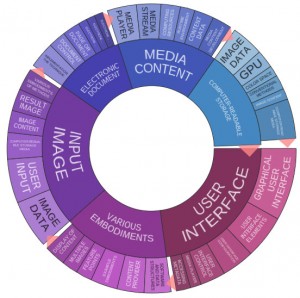 total of 5.9 million users. The company has been dealing with cybersecurity concerns as of late, having to release several patches to address vulnerabilities in Flash programming just this year. A turbulent business climate in China has also prompted Adobe’s decision to pull research and development activities out of that country by the end of 2015.
total of 5.9 million users. The company has been dealing with cybersecurity concerns as of late, having to release several patches to address vulnerabilities in Flash programming just this year. A turbulent business climate in China has also prompted Adobe’s decision to pull research and development activities out of that country by the end of 2015.
With 345 patents granted by the U.S. Patent and Trademark Office in 2013, Adobe Systems placed 105th in the world for U.S. patent grants received that year. In 2014, Adobe received 434 patents from the USPTO, according to Innography’s patent research tools. The Innography text cluster shows a great deal of R&D focus placed upon user interfaces, especially graphical user interfaces, as well as electronic documents and image inputs.
[Companies-1]
Adobe’s Issued Patents: From Mobile Application Development to Collaborative Document Editing
The development of software applications is the focus of a few inventions protected by patents issued to Adobe by the USPTO in recent weeks. More effective methods of testing and debugging mobile applications during development are featured within U.S. Patent No. 8930917, entitled Method and Apparatus for Mobile Application Development and Testing That Avoids Repackaging and Reinstallation. The computer-implemented method protected here involves installing an application and an application driver in the memory of a mobile device, creating a temporary sandbox on the mobile device, writing at least one compiled source code file corresponding to an untested incremental change in an application to the sandbox, testing the compiled source code in the sandbox and discarding the temporary sandbox once testing is complete. The innovation makes it easier for developers to test incremental bugging changes without having the repackage the entire application into the desired deployment format and reinstalling the repackaged application. Techniques for identifying useful software plug-ins for additional application functionality are disclosed and protected by U.S. Patent No. 8893117, titled Interactive Product Improvement Through the Use of Variants and Data Gathering Reports in a System That Can Be Updated on the Fly. This patent claims a system that includes a processor and stored instructions that are executed to determine that a plug-in including a plurality of variants is available, selecting a plug-in variant based on allocation percentages corresponding to percentages of devices receiving the variants and automatically installing the selected plug-in variant, which is executed at run-time. This interactive product improvement system is intended to serve as a way of providing product improvements which isn’t as expensive or time consuming as performing a case study of users to identify improvements.
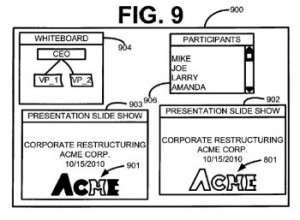 Of course Adobe, which pioneered the use of the Portable Document Format (PDF), would have a number of inventions relating to electronic documents. A better mechanism for uploading an electronic document for use during a network-based conference is discussed within U.S. Patent No. 8943129, issued under the title Document Based Conferencing. This patent claims a computerized method of generating an identifier of a document, receiving a designation of a collaboration server to synchronize actions across multiple instances of the document during a collaboration session, adding the identifiers of the document and the collaboration server within data of the document and storing the document to a local data storage device. This invention supports the capturing and transmitting of modifications and notations to all users within a collaborative document session. Meaningful representations of video and animated content when creating a printed copy of a document containing those elements are possible through the technology protected by U.S. Patent No. 8918714, which is titled Printing a Document Containing a Video or Animations. The computer-implemented method claimed here involves receiving configuring information including a number of frames to display, selecting a plurality of frames from visual content of a multimedia document, extracting the plurality of frames from the visual content, creating a matrix to display the plurality of frames, calculating a reduced representation size for each frame and presenting the multimedia document. This provides a better representation of the content of video or animated elements of an electronic document than conventional methods of printing a single frame.
Of course Adobe, which pioneered the use of the Portable Document Format (PDF), would have a number of inventions relating to electronic documents. A better mechanism for uploading an electronic document for use during a network-based conference is discussed within U.S. Patent No. 8943129, issued under the title Document Based Conferencing. This patent claims a computerized method of generating an identifier of a document, receiving a designation of a collaboration server to synchronize actions across multiple instances of the document during a collaboration session, adding the identifiers of the document and the collaboration server within data of the document and storing the document to a local data storage device. This invention supports the capturing and transmitting of modifications and notations to all users within a collaborative document session. Meaningful representations of video and animated content when creating a printed copy of a document containing those elements are possible through the technology protected by U.S. Patent No. 8918714, which is titled Printing a Document Containing a Video or Animations. The computer-implemented method claimed here involves receiving configuring information including a number of frames to display, selecting a plurality of frames from visual content of a multimedia document, extracting the plurality of frames from the visual content, creating a matrix to display the plurality of frames, calculating a reduced representation size for each frame and presenting the multimedia document. This provides a better representation of the content of video or animated elements of an electronic document than conventional methods of printing a single frame.
Although Adobe is traditionally associated with its image editing software products, we noticed a few interesting patents related to technologies for image capture. U.S. Patent No. 8934044, which is titled Systems and Methods for Live View Photo Layer in Digital Imaging Applications, details new approaches for providing an image capture layer within digital image editing applications. The method protected by this patent involves selecting a layer in an image editing application, rendering a view from a camera in at least a portion of the selected layer, rendering a camera film view that includes a menu for controlling camera operation such as capturing an image and inserting the captured camera view into the selected layer. This invention serves a need for a more efficient system of capturing camera images in a layer of an edited image. Enhanced techniques for facial recognition for images captured of a face which 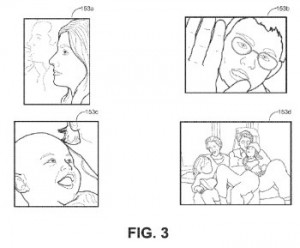 is occluded or slanted are the focus of U.S. Patent No. 8948517, issued under the title Landmark Localization Via Visual Search. This patent claims a computer-implemented method of receiving a test image and a plurality of object images detected to depict an object similar to the test image, receiving a plurality of landmark indicators which indicate the location of a landmark in depicted object images, determining a location of a test image landmark that corresponds with the respective landmark indicator and computing a final test image landmark location based on the determined test image landmark locations. This system improves upon the poor results provided by conventional facial recognition techniques which don’t take into account all possible facial variations when a facial image is partially blocked by an object or slightly askew of the camera.
is occluded or slanted are the focus of U.S. Patent No. 8948517, issued under the title Landmark Localization Via Visual Search. This patent claims a computer-implemented method of receiving a test image and a plurality of object images detected to depict an object similar to the test image, receiving a plurality of landmark indicators which indicate the location of a landmark in depicted object images, determining a location of a test image landmark that corresponds with the respective landmark indicator and computing a final test image landmark location based on the determined test image landmark locations. This system improves upon the poor results provided by conventional facial recognition techniques which don’t take into account all possible facial variations when a facial image is partially blocked by an object or slightly askew of the camera.
[Companies-3]
Patent Applications of Note: From Enforcing Advertiser Rights to Smoother 3D Printing
Digital rights and security of digital content is a recent focus area for Adobe research and development to judge by a few patent applications we came across. U.S. Patent Application No. 20150013019, entitled Methods and Systems for Establishing and Enforcing Document Visibility Rights With an Electronic Signature Service, would protect an electronic signature service that supports a greater degree of customization and flexibility. It claims a method of receiving a request to view a document package that is associated with metadata including document visibility rights for multiple people, identifying document visibility rights associated with a person having invoked the viewing request and generating an instance of an image of the document package with only the portion that viewer has the right to view. The protection of the rights of advertisers to have their online marketing content seen is at the center of U.S. Patent Application No. 20150033023, which is titled Preventing Playback of Streaming Video If Ads Are Removed. This patent protects a digital media processing method of receiving a manifest file identifying each of a plurality of segments in a video stream, storing metadata in the manifest file including a manifest signing enforcement policy comprised of a whitelist and a blacklist of digital media players and using multiple encryption methods to sign the manifest file. This system is capable of preventing streaming digital video from playing through online media players if the video stream has been tampered with to remove advertisements.
 Social networking tools that do a greater job of assessing the efficacy of online marketing campaigns are discussed within U.S. Patent Application No. 20150032510, which is titled Evaluating the Influence of Offline Assets Using Social Networking Resources. The system claimed here includes a post analysis module configured to identify a plurality of social networking events, a geographic analysis module configured to identify a target region encompassing an offline marketing asset and a separate control region, a statistical analysis module configured to allocate the plurality of social networking events to either the target region or control region based on the location of each social networking event and a user interface module configured to display a comparison of the social networking events in the target region to those events in the control region. This system provides analysis of online social networking activities on Facebook, Twitter and elsewhere to determine the efficacy of offline marketing assets. Enhanced methods of networking among many participants of a web conference are featured within U.S. Patent Application No. 20140365291, titled Method and Apparatus for Enabling Participation in a Web Conference as a Virtual Participant. The computer-implemented method claimed here involves establishing a web conference comprising at least one virtual participant, receiving at least one message via a web conference user interface and sending the message to the virtual participant via a selected method of message delivery. This system enables those who want to virtually participate in a web conference even if they don’t have the ability to stay at their computer throughout the conference.
Social networking tools that do a greater job of assessing the efficacy of online marketing campaigns are discussed within U.S. Patent Application No. 20150032510, which is titled Evaluating the Influence of Offline Assets Using Social Networking Resources. The system claimed here includes a post analysis module configured to identify a plurality of social networking events, a geographic analysis module configured to identify a target region encompassing an offline marketing asset and a separate control region, a statistical analysis module configured to allocate the plurality of social networking events to either the target region or control region based on the location of each social networking event and a user interface module configured to display a comparison of the social networking events in the target region to those events in the control region. This system provides analysis of online social networking activities on Facebook, Twitter and elsewhere to determine the efficacy of offline marketing assets. Enhanced methods of networking among many participants of a web conference are featured within U.S. Patent Application No. 20140365291, titled Method and Apparatus for Enabling Participation in a Web Conference as a Virtual Participant. The computer-implemented method claimed here involves establishing a web conference comprising at least one virtual participant, receiving at least one message via a web conference user interface and sending the message to the virtual participant via a selected method of message delivery. This system enables those who want to virtually participate in a web conference even if they don’t have the ability to stay at their computer throughout the conference.
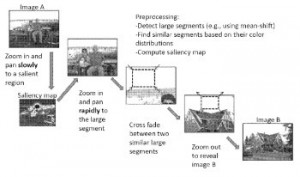 Slideshow presentations which are more engrossing and compelling to an audience are supported by the technology that would be protected by U.S. Patent Application No. 20140337721, filed under the title Content Aware Slideshows. This patent application would protect a method of analyzing multiple images to determine a sequence of the images in which each pair of consecutive images in the sequence has a similar region and applying a transition effect for each of the pairs of images so that the similar region of each consecutive image is aligned during transition. This innovation provides a dynamic system for improving the suitability or “goodness,” to use the patent application’s term, of an effect for transitioning between images.
Slideshow presentations which are more engrossing and compelling to an audience are supported by the technology that would be protected by U.S. Patent Application No. 20140337721, filed under the title Content Aware Slideshows. This patent application would protect a method of analyzing multiple images to determine a sequence of the images in which each pair of consecutive images in the sequence has a similar region and applying a transition effect for each of the pairs of images so that the similar region of each consecutive image is aligned during transition. This innovation provides a dynamic system for improving the suitability or “goodness,” to use the patent application’s term, of an effect for transitioning between images.
E-commerce services developed by Adobe can be better utilized with third-party vendors with the innovation outlined within U.S. Patent Application No. 20140316943, titled Method and Apparatus for Integrating an E-Commerce Provider With Third-Party Vendors. The computer-implemented method of this invention involves receiving an order from a vendor comprising a vendor identification, a fulfillment identification and a vendor stock keeping unit (SKU), mapping the fulfillment identification to a user identification, mapping the vendor SKU to a provider SKU, generating a provisional call responsive to the mapping and provisioning the SKU for the user identification in the database of the provider in response to the call. This system is designed to increase the ease of interpreting orders from app vendors, such as iTunes or Amazon, which typically have unique sales processes which makes tracking inventory and order information difficult for e-commerce providers.
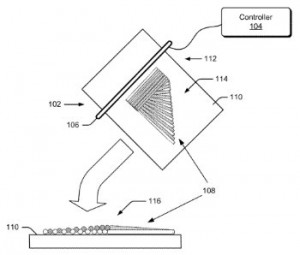 Finally, we were intrigued to see Adobe trying to enter the growing sphere of 3D printing through the filing of U.S. Patent Application No. 20140311651, filed under the title Offset 3D Printing. The method that would be protected by this patent application involves providing a contoured first stage of first parallel filaments having offsets that separate the filaments and providing a second contoured stage of second parallel filaments over the first stage of filaments so that the second parallel filaments are placed between the contours of the first and second stages. This technique is intended to achieve a smoother finished surface to 3D printed products which is caused by the size of the filaments; larger filament sizes can create a “stepped” look to a printed object when a machine for fused deposition modeling has to move from one layer to another.
Finally, we were intrigued to see Adobe trying to enter the growing sphere of 3D printing through the filing of U.S. Patent Application No. 20140311651, filed under the title Offset 3D Printing. The method that would be protected by this patent application involves providing a contoured first stage of first parallel filaments having offsets that separate the filaments and providing a second contoured stage of second parallel filaments over the first stage of filaments so that the second parallel filaments are placed between the contours of the first and second stages. This technique is intended to achieve a smoother finished surface to 3D printed products which is caused by the size of the filaments; larger filament sizes can create a “stepped” look to a printed object when a machine for fused deposition modeling has to move from one layer to another.

![[IPWatchdog Logo]](https://ipwatchdog.com/wp-content/themes/IPWatchdog%20-%202023/assets/images/temp/logo-small@2x.png)


![[Advertisement]](https://ipwatchdog.com/wp-content/uploads/2024/04/Artificial-Intelligence-2024-REPLAY-sidebar-700x500-corrected.jpg)
![[Advertisement]](https://ipwatchdog.com/wp-content/uploads/2024/04/UnitedLex-May-2-2024-sidebar-700x500-1.jpg)
![[Advertisement]](https://ipwatchdog.com/wp-content/uploads/2024/04/Patent-Litigation-Masters-2024-sidebar-700x500-1.jpg)

![[Advertisement]](https://ipwatchdog.com/wp-content/uploads/2021/12/WEBINAR-336-x-280-px.png)
![[Advertisement]](https://ipwatchdog.com/wp-content/uploads/2021/12/2021-Patent-Practice-on-Demand-recorded-Feb-2021-336-x-280.jpg)
![[Advertisement]](https://ipwatchdog.com/wp-content/uploads/2021/12/Ad-4-The-Invent-Patent-System™.png)






Join the Discussion
No comments yet.